Aspen Escape
A project in Aspen goes green from the ground up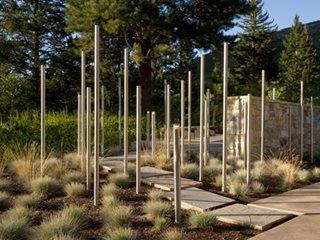
Photo by: Jason Dewey.
At the intersection of rustic and chic, The North Face and Christian Dior, lies Aspen, Colorado. Originally a working city of silver miners, it has become a haven for well-heeled snow-skiing devotees and celebrities from Clint Eastwood to Lance Armstrong looking for a paparazzi break. Surrounded on three sides by mountains, it is nestled neatly in the wilderness, and the natural beauty is one of the big draws.
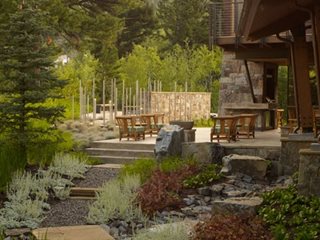
Photo by: Jason Dewey.
Paradoxically, the exodus to the hills has put serious stresses on the very nature that sparked it. That's what happens in a town only 3.5 miles square - at some point there's really nowhere else to go, or to build. The challenge is to balance the needs of an active citizenry with the protection of the landscape.
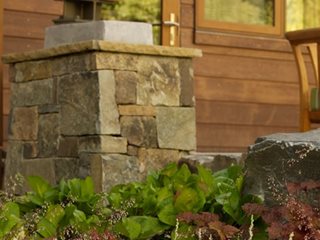
Photo by: Jason Dewey.
That was the situation facing Valerie Alexander Yaw, principal with Aspen-based landscape architecture firm Bluegreen, when she began a project on the eastern edge of town, in an area along the Roaring Fork River called Stillwater. Situated near the North Star Nature Preserve (an area of tremendous biological diversity affiliated with the Nature Conservancy), the neighborhood, which has large lots and steep topography, has more in common with the preserve than the town proper, including stands of trees hundreds of years old. Alexander Yaw calls the area a "little gem in the valley." Of particular concern at the Stillwater location was a colony of Ponderosa pines some 100 years old, somewhat unusual for the region, especially for their venerable age and size.
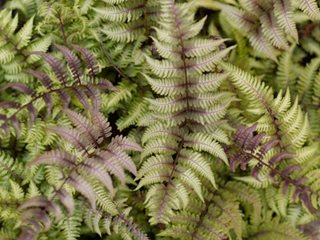
Photo by: Jason Dewey.
On Alexander Yaw's green to-do list, "site preservation comes first," and for this project, it was fortuitous that she was able to work closely with the architect (Bill Poss of Poss Architecture + Planning) and the contractor from the outset. And by happy coincidence, the client very much had green in mind. As Jason Jones, consulting arborist with Aspen Tree Service, remembers it, "The homeowner said, 'Let's do this right,' which hardly ever happens." Despite having one of the most progressive tree-preservation codes in the country, even Aspen can fall short when it comes to protecting large, fragile trees if faced with homeowners who aren't sensitive. As Jones explains, all it takes to lose an awe-inspiring stately specimen is one root-severing trench for irrigation or a walkway. In this case, the client was even willing to make design changes and reduce square footage in the interest of preserving the forest.
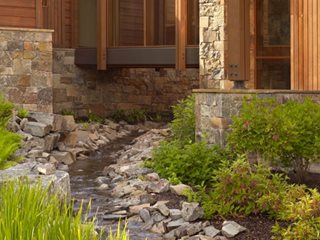
Photo by: Jason Dewey.
While protecting the natural surroundings is paramount, the constructed parts of a project present endless possibilities for Bluegreen to be green. According to Alexander Yaw, approaching an integrated house-and-garden project like Stillwater from a sustainability perspective means thinking about every layer in the design process, right down to the tiniest details, "from vision through implementation, including project goals, materials specifications, construction methods, and even maintenance and user manuals." This runs the gamut from siting trees to assist with heating and cooling the house, to channeling runoff, to irrigation rain sensors, to the concrete mix used in the foundation. Some of it "isn't very sexy," as Alexander Yaw puts it, but the behind-the-scenes eco-sound elements can have a big impact on the total picture and present some interesting design opportunities.
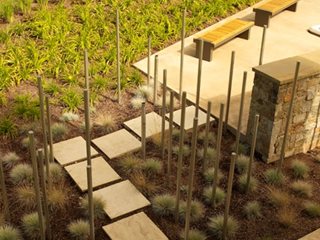
Photo by: Jason Dewey.
For example, after construction, unused building materials are usually hauled away to the dump, but at Stillwater, the leftover stone veneer from the house was recycled into a bed for the man-made stream that runs under a walkway between the main house and guesthouse. Existing granite boulders were integrated into the terraces, not only reducing the energy needed to remove them, but also anchoring the house and garden in the landscape. And for Bluegreen, aesthetic considerations are always on a parallel course with sustainability - the stones in the stream and the boulders are beautiful as well as smart.
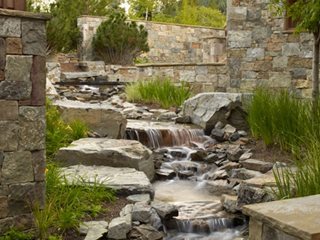
Photo by: Jason Dewey.
Water is a key component in the garden, and Bluegreen has thought of everything here as well. Runoff from rain and snowmelt is channeled into a stream that empties into a small pool at the edge of the bluff overlooking a large natural pond and wetland, visually connecting the built landscape with the natural one. The water also cools the house in the summer and provides an irrigation resource. The plantings include many natives, such as aspen and amelanchier, and revegetation was an important part of post-construction. The limited plant palette at 9,000-feet elevation also meant Bluegreen could be "playful with the plant material," says Alexander Yaw, and nonnatives are part of the mix, though the selection was carefully tailored to microclimates around the house (which minimizes maintenance).
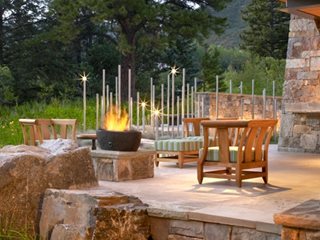
Photo by: Jason Dewey.
But living in Aspen is also about reveling in your surroundings. At Stillwater, the house and garden were sited for maximum viewing pleasure (from windows, seating areas, apertures in garden walls) and a series of three outdoor terraces adjoin the home office, living room and kitchen. From the first terrace with its stainless-steel reflecting pool, a walkway leads past beds of perennials - Artemisia, Bergenia, Heuchera - to a terrace for dining and relaxing, complete with a copper fire pit and an outdoor kitchen hidden within an architectural column.
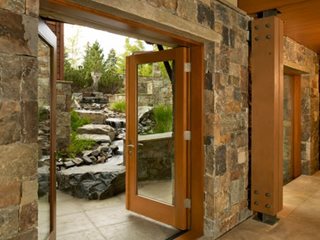
Photo by: Jason Dewey.
The third terrace introduces a bit of landscape art and whimsy with a grouping of stainless-steel poles meant to be an abstraction of the forest beyond. They're also a handy place to hang your robe when indulging in the nearby spa, and some poles are outfitted as outdoor lighting. The "pokey poles," as Alexander Yaw and her team call them, were created by Bluegreen, proving that the landscape architecture firm really can handle every aspect of a project, from the practical to the sublime. As Alexander Yaw puts it, "We consider ourselves artists."
To bring the element of water onto the site (the ocean being one of the obvious reasons people move to the Hamptons, though this property isn't ocean adjacent), Groft designed a small pool of aquatic plants just off the terrace outside the living room. Sited just so, the late-afternoon sun reflects off the water, casting a warm glow into the house. A swimming pool beyond, behind the garage (which doubles as a pool house), has a lap-pool area as well as a shallow wading pool for little ones. Groft designed the pool to fit easily into the landscape, surrounding it with lush plantings that are reflected picture-perfect in the water, at least when the grandchildren aren't splashing about. With the ocean only 600 feet away beyond the hedge and within easy earshot, sitting in a deck chair by the pool, the homeowner can feel like she's at the beach, enjoying the life of a Hamptonite, but with a natural twist.
No Detail Too Small
Often one of a site's greatest assets is what is already there. This is especially true if a location is near a natural area or preserve. Be mindful of the nearby landscape, not only for its beauty but also as a vulnerable habitat for native plants and wildlife. Call in an expert to evaluate the site and offer advice for protecting it. And don't forget to preserve beautiful views when siting trees and outdoor-living areas.
Integrate: Ideally a house and garden should harmonize in form and function. Close coordination can also have a cumulative effect on sustainability. No detail is really too small - from LED lighting, to irrigation rain sensors, to the type of concrete used, to recycling materials. The best and greenest results happen when client, architect, landscape designer and contractor are on the same page.
Protect: Construction is a critical time, and the best-laid plans can quickly go awry, sometimes irreparably. In a few minutes, a trenching machine can destroy the root system of a tree that has withstood hundreds of years of weather vagaries, human intervention and natural disasters. Equipment parked on-site can ruin soil structure. Be vigilant with anyone and anything participating in the building of your home and garden.
Get tips for designing a garden in the mountains.
